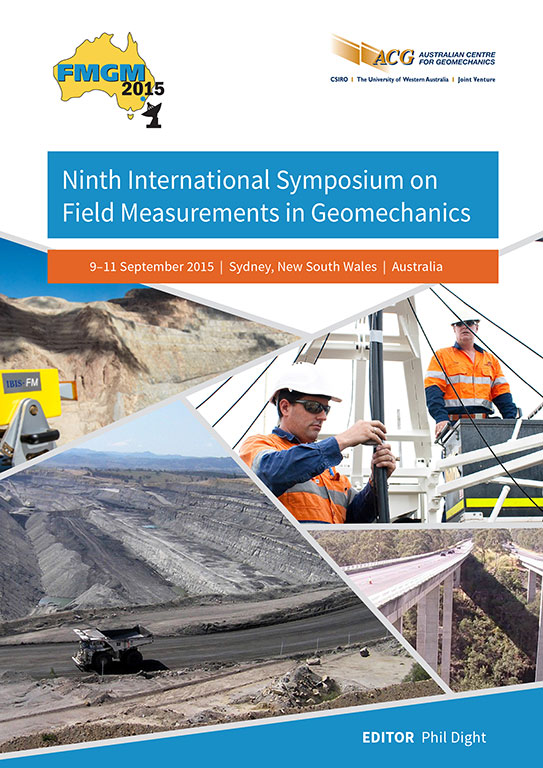Wireless landslide monitoring — triggering factors and dynamic behaviour

|
Authors: Abancó, C; Paretas‐Martínez, J; Falgàs, E; Pérez‐Arcas, J; Hürlimann, M |
DOI https://doi.org/10.36487/ACG_rep/1508_57_Abanco
Cite As:
Abancó, C, Paretas‐Martínez, J, Falgàs, E, Pérez‐Arcas, J & Hürlimann, M 2015, 'Wireless landslide monitoring — triggering factors and dynamic behaviour', in PM Dight (ed.), FMGM 2015: Proceedings of the Ninth Symposium on Field Measurements in Geomechanics, Australian Centre for Geomechanics, Perth, pp. 781-788, https://doi.org/10.36487/ACG_rep/1508_57_Abanco
Abstract:
Monitoring is fundamental for the prediction and analysis of landslide triggering factors and dynamic behaviour and major issues in the hazard assessment and risk mitigation. Wired monitoring systems have traditionally been used in landslide monitoring. However, wireless technologies are escalating in this field as a consequence of their multiple advantages against standard wired systems, such as their versatility and lower power consumption. Wireless monitoring is a perfect solution for the acquisition of data on geological processes in remote areas where power availability is scarce and the position of the sensors is often a critical issue due to the landscape conditions. In this paper, a complete landslide wireless monitoring system is described within the context of a successful case study in the Central Pyrenees, Spain. The Rebaixader constitutes a typical high mountain catchment where landslides and torrential processes occur with a sub-annual frequency. Rainfall is the principal triggering factor of the type of landslides occurring at the Rebaixader (debris flows), but the specific details of the geotechnical mechanisms that originate the events is still not clear. In order to increase the knowledge on the processes occurring at the catchment, it was equipped with a Loadsensing network for the monitoring of triggering factors and a Spidernano Seismic Remote Unit for the acquisition of the ground vibration generated by the moving mass. The Loadsensing sensor network incorporates seven nodes provided with wireless communication capabilities, showing ultra-low power consumption and long-range communication. Digital, pulse and voltage sensors are connected to these nodes in order to monitor soil water content, soil water potential, snow height, 5-minute rainfall intensity, and air temperature and humidity. The sensor nodes communicate in a multi-hop fashion to deliver the information into a gateway, placed 500 m away in the line of sight, with two repeaters placed along the line. The gateway offers enhanced computational and storage capabilities, as well as 3G modem communication to the data centre. Spidernano is a seismic remote unit (SRU) equipped with GPS clock discipline, which is connected to the Gateway via Ethernet cable. It was connected to three 1D geophones recording simultaneously the ground vibration generated by the passage of the debris-flow mass near the geophones. It has a low power consumption (0.5 W), specially adapted for field campaigns or permanent monitoring. The recordings revealed that debris-flow occurrence can be detected by ground vibration signal and the approach of the flowing mass can even be detected before the arrival. Data acquired by Loadsensing provided valuable results on the understanding of the failure and post-failure mechanisms such as the infiltration patterns of water into the soil before and during the events. All these achievements are promising results for the application of low power wireless technologies not only for standard landslide monitoring but also for landslide early warning systems.
References:
Abancó, C, Hürlimann, M & Moya, J 2014a, ‘Analysis of the ground vibration produced by debris flows and other torrential processes at the Rebaixader monitoring site (Catalan Pyrenees, Spain)’, Natural Hazards and Earth System Science, vol. 14, pp. 929-943.
Abancó, C, Hürlimann, M & Moya, J 2014b, ‘Towards a debris-flow warning system based on hydrological measurements of the triggering conditions. A study of El Rebaixader catchment (Central Pyrenees, Spain)’, Geophysical Research Abstracts, vol. 16.
Costa, JE 1984, ‘Physical geomorphology of debris flows’, in JE Costa & PJ Fleisher (eds), Developments and applications of geomorphology, Springer-Verlag, Berlin, pp. 268-317.
Cruden, DM & Varnes, DJ 1996, ‘Landslide types and processes’, in KA Turner & RL Schuster (eds), Landslides: investigation and mitigation, Transport Research Board Special Report, vol. 247, pp. 36-75.
Hungr, O, McDougall, S & Bovis, M 2005, ‘Entrainment of material by debris flow’, in M Jakob & O Hungr (eds), Debris-flow Hazards and Related Phenomena, Springer, Berlin, pp. 135-158.
Hungr, O, Leroueil, S & Picarelli, L 2014, ‘The Varnes classification of landslide types, an update’, Landslides, vol. 11, no. 2,
pp. 167-194.
Hürlimann, M, Abancó, C, Moya, J & Vilajosana, I 2014, ‘Results and experiences gathered at the Rebaixader debris-flow monitoring site, Central Pyrenees, Spain’, Landslides, vol. 11, no. 6, pp. 939-953.
Jakob, M & Hungr, O 2005, Debris-flow Hazards and Related Phenomena, Springer, Berlin.
Johnson, AM & Rodine, JR 1984, ‘Debris flow’, in D Brunsden & DB Prior (eds), Slope Instability, John Wiley and Sons, Inc., New York, NY, pp. 257-361.
Muñoz, JA 1992, ‘Evolution of a continental collision belt: ECORS-Pyrenees crustal balanced cross-section’, in KR McClay (ed.), Thrust Tectonics, Chapman & Hall, pp. 235-246.
UAB 2004, Universitat Autònoma de Barcelona, Climatic Atlas of Catalonia, Barcelona, viewed 22 July 2012,
uab.cat/acdc/
© Copyright 2025, Australian Centre for Geomechanics (ACG), The University of Western Australia. All rights reserved.
View copyright/legal information
Please direct any queries or error reports to repository-acg@uwa.edu.au
View copyright/legal information
Please direct any queries or error reports to repository-acg@uwa.edu.au